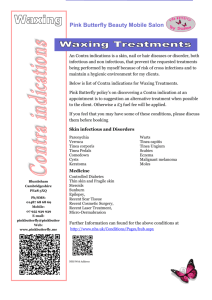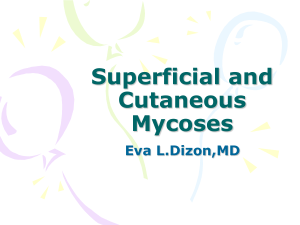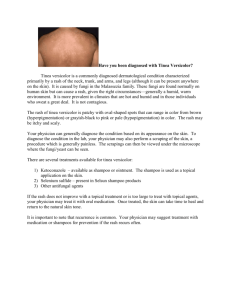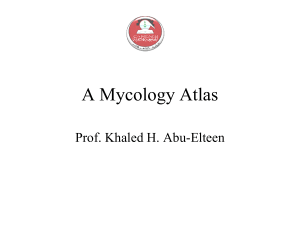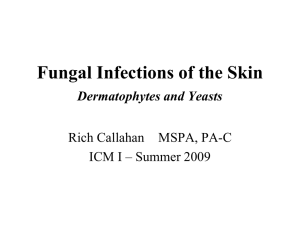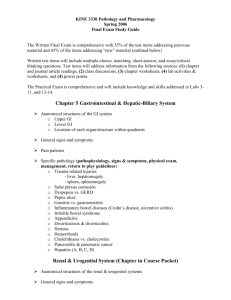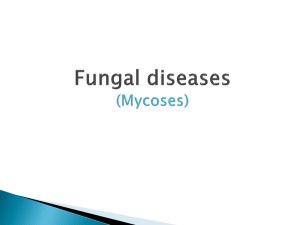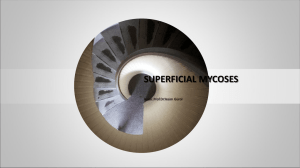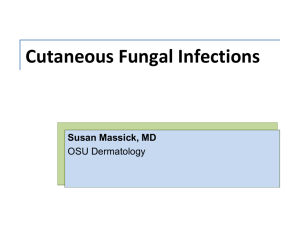File - Medical Mycology
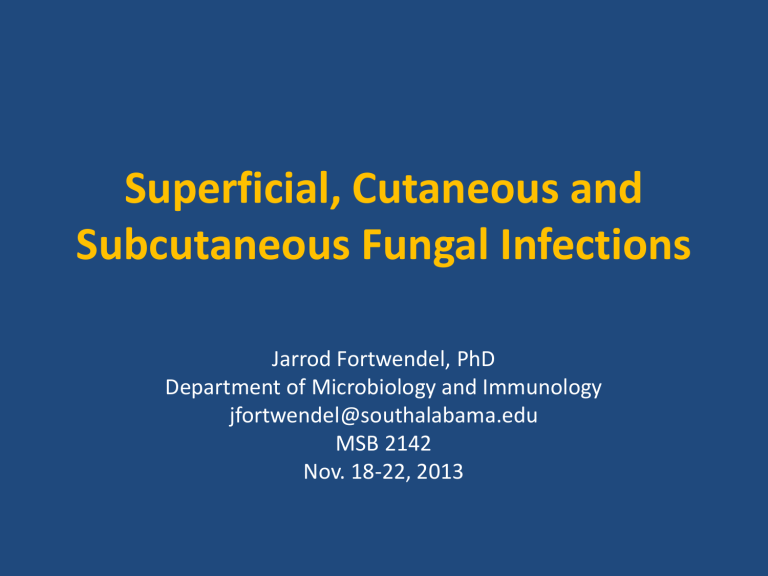
Superficial, Cutaneous and
Subcutaneous Fungal Infections
Jarrod Fortwendel, PhD
Department of Microbiology and Immunology jfortwendel@southalabama.edu
MSB 2142
Nov. 18-22, 2013
Tinea Capitis in an Adult Woman
• 87 yo woman presents to her doctor with a 2-year history of puritic, painful, scaling scalp eruption and hair loss
• Previous treatment included numerous courses of systemic antibiotics and prednisone without success
• Social history: recently acquired several stray cats that she kept inside her home
• Physical exam: numerous pustules throughout the scalp, diffuse erythema, crusting, and scale extending to neck.
Extremely sparse scalp hair and prominent posterior lymphadenopathy. No nail pitting.
• Wood light positive
• Presumptive diagnosis: Tinea Capitis
Cutaneous (and Superficial) Mycoses
• Infections of the skin, hair, nail
• Invades keratinized layers
• Tinea – latin for “worm”
• Subgroups of infections
1. Dermatophytoses – “classical ringworm”
2. Non-dermatophytic cutaneous mycoses…
“the other superficial group”
The Dermatophytes –
Classical ringworm - #1 mould infection
• Epidemiology
– Anthropophilic, zoophilic, geophilic
– Transmissible
– Invade skin, hair and nails
– Collectively called “tinea”
– 3 major Genera:
• Trichophyton
• Epidermophyton
• Microsporum
The Dermatophytes –
Classical ringworm - #1 mould infection
• Epidemiology
– Anthropophilic, zoophilic, geophilic
– Transmissible
– Invade skin, hair and nails
– Collectively called “tinea”
– 3 major Genera:
• Trichophyton
• Epidermophyton
• Microsporum
T. rubrum
T. mentagrophytes
Cause 80-90% of cases worldwide
The Dermatophytes: Pathogenesis
• Virulence factors and pathogenesis:
– Infectious element
• Arthroconidia
– Keratin utilization
• Keratinophilic and keratinolytic
– Hair invasion/colonization
• Endothrix, Ectothrix, Favic
Clinical: Classified by anatomical site affected
• Tinea capitis
– Microsporum spp. –
• M. audouinii, gray patch ringworm
• M. canis, M. gypseum
• Tinea corporis – point lesion centrifugal spread – anywhere on body from eyebrow and neck “southward”
– Trichophyton spp., Epidermophyton, (Also Candida)
• Tinea pedis
– cosmopolitan
– Trichophyton spp., Epidermophyton
• Tinea unguium
– Often as a secondary infected site
– Almost any dermatophyte, esp Trichophyton rubrum, (Also Candida)
Tinea capitis
Tinea corporis
Tinea imbricata
Etiology: Trichophyton concentricum
Tinea cruris
Tinea cruris
Tinea unguium - onychomycosis
Tinea barbae
Tinea manum
Dermatology Image Atlas: Dermatology Images - dermatlas.med.jhmi.edu
Tinea pedis
The Dermatophytes - Zoophilic
The Dermatophytes - Zoophilic
Laboratory Diagnosis
• Requires demonstrating hyphae/arthroconidia from skin, hair, nails
• Direct preparation:
• Lesion scrapings/hair examined by calcofluor/KOH
• Alternatively - Wood’s Light:
• UV irradiation of infected hair, false positive/negative
• Report: Hyphal fragments/arthrocondida seen
• Culture: SDA +; SDA-CC + LPCB
Direct KOH prep: Hyphal fragments seen http://www.mycology.adelaide.edu.au/virtual/2009/ID2-Oct09.html
The Dermatophytes:
Morphology
Epidermophyton spp.
- Smooth walled macroconidia borne in clusters of 2 or 3; no microconidia
Trichophyton spp.
- Rare, smooth, thin-walled macroconidia; numerous spherical or teardrop shaped microconidia
Microsporum spp.
- Numerous, large, thick, rough-walled macroconidia; rare microconidia
Treatment of the dermatophytoses
• Localized cutaneous - topical agents
– Clotrimazole (Lotrimim), Miconazole (micatin)
– Tolnaftate (tinactin), terbinafine (lamisil)
• Hair, nails – oral therapy
– Fluconazole, itraconazole, griseofulvin
• Griseofulvin
– Concentrates in newly keratinized layers of cells
– Virtually eradicated epidemic tinea capitis; used in tinea unguium and extensive infections.
• Recurrences are common
Non-dermatophytic Onychomycosis:
• Candida spp.
– Fluconazole
• Scopulariopsis spp.
• Scytalidium spp.
– partial surgical nail removal + antifungal
• **Possible other nail pathogens:
– Aspergillus spp.
– Fusarium spp.
– Acremonium spp.
** nail pathogen vs. saprobe on abnormal nail material **
Must have: > 1 KOH positive!!
> culture positive isolation of same agent!!
**R/O fungal contamination of the culture**
Case resolution…
• Wood Light – positive
• Skin biopsy
– Enterococcus spp. and Trichophyton tonsurans
– Endothrix dermatophyte infection
• Treated with griseofulvin and Selsun
• New hair growth and resolution of pustular eruption at 2 week follow-up
• Treatment continued for 8 weeks with complete hair re-growth and no permanent alopecia
Superficial Mycoses
• Tinea versicolor – AKA pityriasis versicolor
– Malessezia furfur
• Tinea nigra palmaris
– Hortaea (Exophiala) werneckii
• Piedra – black
– Piedraia hortai
• Piedra – white
– Trichosporon beigelii
Superficial Mycoses
• Tinea versicolor – AKA pityriasis versicolor
– Malessezia furfur
• Very common – up to 60% infected population in certain tropical environments
• Most common in tropic and subtropics
• Person-to-person transfer
• Liopophilic fungus that degrades lipids to produce acids that damage melanocytes = hypopigmented patches w/ dark skin, pink or brown w/ light skin
• Little-to-no host immune reaction
Tinea (pityriasis) versicolor
Chest
Back
Skin Scraping – Direct Prep (KOH)
“Spaghetti and meatballs”
• Diagnosis made by direct exam
• Does not culture routinely - lipophilic
• Treatment: 2.5 % Selenium sulfide or topical cream azoles
– Severe cases: Oral ketoconazole
“collarette”
Superficial Mycoses
• Tinea versicolor – AKA pityriasis versicolor
– Malessezia furfur
• Tinea nigra
– Hortaea (Exophiala) werneckii
• Piedra – black
– Piedraia hortai
• Piedra – white
– Trichosporon beigelii
Superficial Mycoses
• Tinea versicolor – AKA pityriasis versicolor
– Malessezia furfur
• Tinea nigra
– Hortaea (Exophiala) werneckii
– Superficial phaeohyphomycosis
– Solitary, irregular, pigmented macule usually on palms or soles
– Tropic or subtropic
– Traumatic inoculation
– Not contagious
– Can resemble a malignant melanoma
Tinea nigra – H. werneckii
2. Culture = dematiaceous, yeast-like colony in 3 weeks
4. Treatment:
Topical azoles
1. KOH prep = pigmented hyphae and yeast http://www.mycology.adelaide.edu.au/virtual/2007/ID2-Feb07.html
3. Microscopic
= two-celled, cylindrical, yeast-like cells http://www.mycology.adelaide.edu.au/virtual/2007/ID2-Feb07.html
Superficial Mycoses
• Tinea versicolor – AKA pityriasis versicolor
– Malessezia furfur
• Tinea nigra palmaris
– Hortaea (Exophiala) werneckii
• Piedra – black
– Piedraia hortae
• Piedra – white
– Trichosporon beigelii
Superficial Mycoses
• Tinea versicolor – AKA pityriasis versicolor
– Malessezia furfur
• Tinea nigra palmaris
– Hortaea (Exophiala) werneckii
• Piedra – black
– Piedraia hortae
• Tropical, poor hygiene, uncommon
• Small, dark nodules surrounding hair shaft
• Clumped together by cement-like substance with asci and ascospores
• Diagnosis = direct exam
• Treatment = haircut, washing
Superficial Mycoses
• Tinea versicolor – AKA pityriasis versicolor
– Malessezia furfur
• Tinea nigra palmaris
– Hortaea (Exophiala) werneckii
• Piedra – black
– Piedraia hortai
• Piedra – white
– Trichosporon beigelii
– Tropical and subtropical, poor hygiene
– Affects hairs of groin and axillae
– Forms soft, white/brown swelling on hair shaft
– Shaving and washing
Superficial Mycoses
• Tinea versicolor – AKA pityriasis versicolor
– Malessezia furfur
• Tinea nigra palmaris
– Hortaea (Exophiala) werneckii
• Piedra – black
– Piedraia hortai
• Piedra – white
– Trichosporon beigelii
• Other non-dermatophytic (several)
– E.g. Candida, Fusarium, and more…
Subcutaneous mycoses
• AKA: Inoculation Mycoses – normal soil inhabitants
• Primary infection in deep skin, muscle or connective tissue
• Slowly progressive and chronic, usually confined
• Not transmissible
• Subgroups of subcutaneous mycoses
I.
Sporotrichosis
II.
Chromoblastomycosis/Phaeohyphomycosis
III.
Mycetoma
IV.
Subcutaneous Zygomycosis
Sporotrichosis – Sporothrix schenkii
• Epidemiology :
– Decaying vegetation, esp used for mulching
– Enters via splinters, thorn pricks
-Occupational hazard
• Clinical Aspects:
– Primary nodular lesion necrotic ulcer, suppurative
– Proximal lymphatics may chronically infect (dissemination rare)
• Sporothrix schenckii:
– Direct prep: RARE blastoconidia
– Sporothrix is a thermal dimorph
– At RT: DEMATIACEOUS colony, HYALINE septate hyphae, delicate lateral conidiophores w/ delicate rosettes of conidia
– At 37°C in vivo & in vitro: oval, cigar-shaped blastoconidia.
• Treatment:
– Itraconazole
Chromoblastomycosis
• Epidemiology:
– tropics – PR, Cuba, Costa Rica and Brazil
– Soil saprobes; dematiaceous fungi
– Trauma is required, occurs when shoes are rarely worn
• Clinical Manifestations:
– Not contagious
– Incubation unknown
– Chronic skin and subcutaneous infections
– Small raised papule, ulcerates & encrusts dry, raised lesion usually on foot/leg
– Satellite lesions hyper-elevate - 10-15 yrs from onset
Chromoblastomycosis –
Clinical Manifestations
Chromoblastomycosis
• Laboratory Diagnosis:
– Direct Prep: Copper-colored, multiple dividing cells
– Three major organisms: Cladosporium, Fonsecaea, Phialophora
– Culture = differ by conidial structures
– Can be considered dimorphs – yeast-like in vivo, mould in vitro
• Treatment:
– Specific antifungals usually ineffective
– Itraconazole, terbinafine, or posaconazole
– Combined with 5-fluorocytosine in refractory cases
Phaeohyphomycosis
• Epidemiology:
– Syndrome caused by more than 20 different saprobes
– Fungi appear in tissue as irregular hyphae, not the sclerotic cells seen in Chromoblastomycosis
– Traumatic inoculation
• Clinical syndromes:
– Solitary inflammatory cyst
– Slow growing (months to years)
• Laboratory Diagnosis:
– Surgical excision of cyst = inflammatory cyst with fibrous capsule, necrosis, fungal elements
• Treatment:
– Surgical excision
– Itraconazole, posaconazole, voriconazole, terbinafine
Mycetoma
• Epidemiology :
– tropical & subtropical
– Soil saprobes
– Trauma required for inoculation
• Clinical Manifestations:
– Not contagious
– Swollen deep seated lesion of hand or foot
Mycetoma – Clinical Manifestation
Mycetoma
• Laboratory diagnosis:
– Caused by many diverse microbes
– Eumycetoma (fungal mycetoma)
• Scedosporium (teleomorph Pseudallescheria)
• Resistant to Amphotericin B!
– Actinomycetoma (actinomycotic mycetoma)
• Actinomyces, Nocardia, Actinomadura, Streptomyces
• Treatment:
– Bacterial – antibiotics
– Fungal – surgery and long-term treatment
Subcutaneous Zygomycosis
• Epidemiology:
– Africa, India, Latin America
– Traumatic implanation
• Conidiobolus coronatus and Basidiobolus ranarum
• Clinical Syndromes:
– B. ranarum – large, movable mass localized to shoulder, pelvis, hip and thigh
– C. coronatus – confined to rhinofacial area
• Laboratory diagnosis:
– Biopsy = focal clusters of inflammation, eosinophils, zygomycete hyphae
• Treatment:
– Itraconazole
